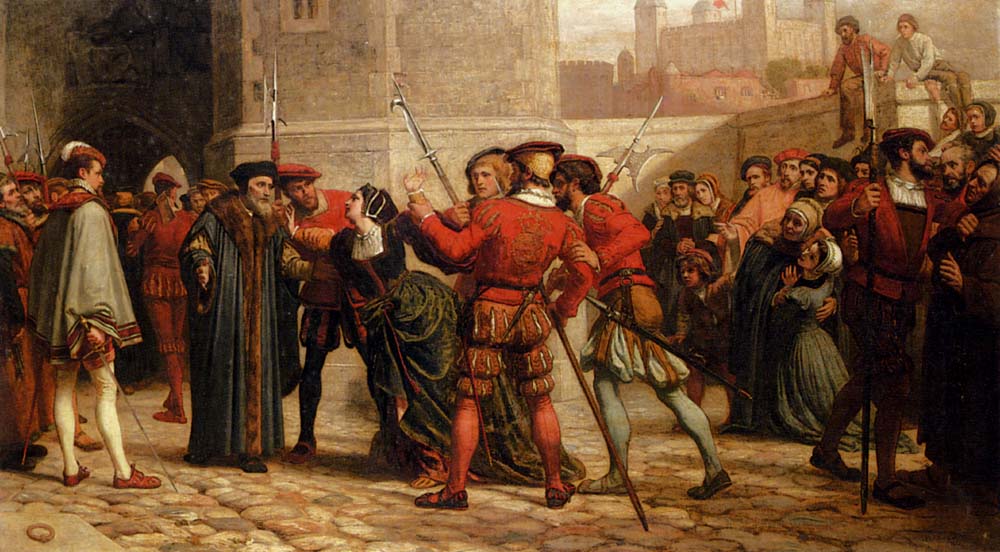
Schmalz. A Man for All Seasons: St. Thomas More

Spring: The First Meeting with Erasmus in the London House in 1499.

Summer: Alice and Thomas More Playing the Lute in the Evening.
In the background More’s daughters by his first marriage: Margaret Roper (left) and Cecily Heron (right).

Autumn: King Henry VIII at More’s House in Chelsea.
The king unsuccessfully attempts to persuade More on the annulment of his marriage to Catherine of Aragon.

Winter: More’s Execution on Tower Hill.
More kisses the executioner as a symbol of forgiveness and consolation.

Holbein Hans (the Younger) (1497/8-1543). Sir Thomas More, 1527

Holbein-Family Portrait of Sir Thomas More

Holbein Hans (the Younger). Study for the Family Portrait of Sir Thomas More (c. 1527)

Lockey Rowland (active 1593-1616 after Hans Holbein the Younger). Sir Thomas More with His Family

Cowper Frank Cadogan (1877-1958). Erasmus and Thomas More Visit the Children of Henry VII at Greenwich, 1499

Yeames William Frederick (1835-1918). The Meeting of Sir Thomas More with His Daughter after His Sentence of Death
|
Thomas More was born in London in 1478, son of Sir John More, a prominent judge. As a youth he served as a page in the household of Archbishop Morton.
Around 1494 More was admitted to Lincoln's Inn, London, in 1496, and became a barrister in 1501. While at Lincoln's Inn, he determined to become a monk and subjected himself to the discipline of the Carthusians, living at a nearby monastery and taking part of the monastic life. The prayer, fasting, and penance habits stayed with him for the rest of his life. More's desire for monasticism was finally overcome by his sense of duty to serve his country in the field of politics. He entered Parliament in 1504, and married for the first time in 1504 or 1505. More became a close friend with Desiderius Erasmus during the latter's first visit to England in 1499. It was the beginning of a lifelong friendship and correspondence. One of More's first acts in Parliament had been to urge a decrease in a proposed appropriation for King Henry VII. In revenge, the King had imprisoned More's father and not released him until a fine was paid and More himself had withdrawn from public life. After the death of the King in 1509, More became active once more. In 1510, he was appointed one of the two undersheriffs of London. In this capacity, he gained a reputation for being impartial, and a patron to the poor. In 1511, More's first wife died in childbirth. More was soon married again, to Dame Alice. During the next decade, More attracted the attention of King Henry VIII. In 1515 he accompanied a delegation to Flanders to help clear disputes about the wool trade. Utopia opens with a reference to this very delegation. More was also instrumental in quelling a 1517 London uprising against foreigners. More accompanied the King and court to the Field of the Cloth of Gold. In 1518 he became a member of the Privy Council, and was knighted in 1521. More helped Henry VIII in writing his Defence of the Seven Sacraments, a repudiation of Luther, and wrote an answer to Luther's reply under a pseudonym. More had garnered Henry's favor, and was made Speaker of the House of Commons in 1523 and Chancellor of the Duchy of Lancaster in 1525. As Speaker, More helped establish the parliamentary privilege of free speech. He refused to endorse King Henry VIII's plan to divorce Katherine of Aragón (1527). Nevertheless, after the fall of Thomas Wolsey in 1529, More became Lord Chancellor, the first layman yet to hold the post. While his work in the law courts was exemplary, his fall came quickly. He resigned in 1532, citing ill health, but the reason was probably his disapproval of Henry's stance toward the church. He refused to attend the coronation of Anne Boleyn in June 1533, a matter which did not escape the King's notice. In 1534 he was one of the people accused of complicity with Elizabeth Barton, the nun of Kent who opposed Henry's break with Rome, but was not attainted due to protection from the Lords who refused to pass the bill until More's name was off the list of names. In April, 1534, More refused to swear to the Act of Succession and the Oath of Supremacy, and was committed to the Tower of London on April 17. More was found guilty of treason and was beheaded alongside Bishop Fisher on July 6, 1535. More's final words on the scaffold were: "The King's good servant, but God's First." More was beatified in 1886 and canonized by the Catholic Church as a saint by Pope Pius XI in 1935. (abridged from http://www.luminarium.org/renlit/morebio.htm) Please consult "Pinacotheca Philosophica" |